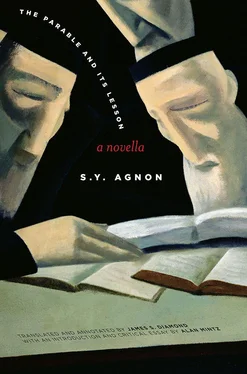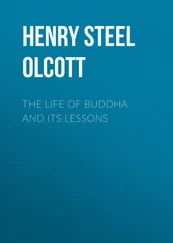Would that my toil has not been for naught nor my effort in vain. And that all who guard their mouth and their tongue will give honor to their Maker and sit in fear and in awe before the One who is above all praise, when the Torah is being read and the prayers are being said, on New Moon and Sabbath and festivals and weekdays. Then the meditation of every heart and the offering of their voices shall ascend in favor before the Lord of all, and they shall be pleasing to God as in days of old, as is written, May the words of my mouth and the meditation of my heart be acceptable to You, O Lord, my Rock and my Redeemer .)
The noble story The Parable and Its Lesson is now complete.
NOTES
1 Khmelnitski pogroms In 1648–49 the Cossack leader Bogdan Khmelnitski, as part of the uprising against the Polish Commonwealth, led a campaign of atrocities against Jews in the Ukraine. Jews were prime targets of Cossack fury because they were agents of the Polish aristocracy, who hired them to manage their estates. As many as tens of thousands of Jews were murdered and many communities were destroyed. The massacres were deeply rooted in the collective memory of Ashkenazic Jewry until the Holocaust overshadowed them. In Jewish annalistic literature Khmelnitski is often referred to as “Khmiel.”
2 through which his soul passes The idea that a name contains the essence of a person has its roots in Kabbalistic doctrine, as does the notion of gilgul neshamot (lit. the cycle of souls), in which the soul of a person cycles through a series of bodily incarnations over time.
6 weekly Torah portion Mishpatim The weekly Torah portion comprising Exodus 21:1–24:18.
6 portion of Ha’azinu The weekly Torah portion comprising Deuteronomy 32.
6 the passage haniglot vehanistarot Lit. “ The revealed and the hidden . ..” These words occur in Deuteronomy 29:28. The authorized Hebrew (Masoretic) text of this verse contains eleven dots above these words and above the first letter of the word that follows. The origin and import of these dots is the subject of both scholarly speculation and midrashic interpretation. The JPS TANAKH renders the verse “Concealed acts concern the Lord our God; but with overt acts, it is for us and our children ever to apply all the provisions of this Teaching.”
6 the piyyut Unetanneh tokef A piyyut is a liturgical poem. The piyyut referred to here, Unetanneh tokef (Let Us Declare the Holiness of the Day), is recited during the Musaf service on Rosh Hashanah and Yom Kippur. Though its origins are earlier, the present text was written by the eleventh-century poet Kalonymus ben Meshullam Kalonymus of Mainz, Germany. Legend attributes it to one Amnon of Mainz, who is said to have composed it as he was being martyred by the local bishop for refusing to convert to Christianity. Three days after his death, so the story goes, he appeared to Kalonymus in a dream and taught him the poem.
7 prayer recited upon Called in Hebrew tefillat haderekh , it is traditionally recited by travelers as they set out on a journey.
8 seven nuptial benedictions Seven benedictions are chanted at the marriage ceremony and at the ensuing wedding feast. During the week following the wedding, tradition mandates that a festive meal for the newlyweds be held each day. At the end of each meal, following the Grace, the seven benedictions are repeated. In order to ensure that the blessings remain fresh, it is customary to make sure there is present at each of the meals at least one “new face,” i.e., someone who did not attend either the wedding ceremony or any of the previous meals. If there is not, the seven benedictions are not recited, except for the blessing over a cup of wine at the conclusion of the Grace after the meal.
8 Kiddushin The talmudic tractate that treats the laws of betrothal.
8 tractate Ḥagigah Kaftor vaferaḥ is a Hebrew treatise on rabbinic aggadah by Yaakov bar Yitzchak Luzzato, Safed, ca. 1527–1587. In the Lemberg, 1891 edition, the tale is found on p. 66a. The talmudic tractate Ḥagigah deals with the laws of the festival sacrifices.
8 Aaron began to inquire It is unclear exactly what kind of inquiry Aaron is engaging in or who he is reading. Clearly it involves the philosophical speculation about first things and the problem of evil that was prevalent in the late seventeenth century.
9 qelipot Lit. shells or husks. The reference is to the complex notion in Lurianic Kabbalah of “the breaking of the vessels.” Qelipot signify the impurity and grossness that adhere to a person living in the unredeemed cosmos.
11 Behukotai The Torah portion comprising Leviticus 26:3–27:34, generally read during May.
12 melamed One who teaches Torah to children.
12 banned by the community The reference is to niddui , a temporary ban (as opposed to excommunication) that could be imposed by the rabbinic authorities to ostracize and discipline a recalcitrant member of the community. The practice goes back to rabbinic times but with modifications was applied by later Jewish communities. It has currency today only in ultra-Orthodox communities.
13 Fear no man Deuteronomy 1:17.
13 Rabbenu Tam’s tefillin Jewish law records a debate between Rashi (1040–1105) and his grandson, Rabbi Jacob Tam (usually referred to as Rabbenu Tam, ca. 1100–1171), over the order in which the parchments containing passages from the Torah are to be positioned inside the tefillin fitted on the head. Jews who are fastidious about the observance of this precept will don both Rashi and Rabbenu Tam tefillin on weekday mornings.
13 Mountains of Darkness See Babylonian Talmud tractate Tamid 32b: “The Tanna de-be Eliyahu taught: Gehinnom is above the firmament; some, however, say that is behind the Mountains of Darkness.”
14 Sabbath of Repentance The Sabbath of Repentance (Hebrew, Shabbat Shuvah ) is the Sabbath between Rosh Hashanah and Yom Kippur. Its name derives from the opening words of the prophetic reading that follows the Torah reading at the morning service: “ Shuvah yisra’el ” (Return, O Israel, to the LORD your God; Hosea 14:2.) It was customary on that Sabbath for the rabbi to present a major discourse or sermon on the theme of repentance to prepare the congregants for Yom Kippur.
15 Israel in the desert See Exodus 13:21ff., 40:34ff., Numbers 9:15–23.
16 Shas A Hebrew acronym for (1) sh omer sefarim , which has the sense of book collector or bibliophile; and (2) “ sh ishah sedarim ” (six orders or parts), a Hebrew designation for the Mishnah, which contains six volumes. The term is used more broadly to denote the many tomes that contain the elaboration of the Mishnah in the sixty-three tractates of the Babylonian Talmud.
16 Akdamut hymn Composed by Meir ben Isaac Nehorai (eleventh century, northern France). The ninety-line piyyut is read by Ashkenazic Jews at the morning service on Shavuot just prior to the reading from the Torah.
17 Gehinnom has seven names Babylonian Talmud, tractate ‘Eruvin 19a.
18 twentieth of Sivan The day on which the Jewish community of Nemirov was destroyed in the Cossack uprising of 1648. It came to be designated as a minor fast day to mark all the Khmelnitski massacres. In the Middle Ages Rabbi Jacob Tam designated the same date as a day of mourning for the Jews burned alive in the blood libel in Blois, France, in 1171.
18 Strypa A tributary of the Dniester river in Galicia, now western Ukraine, on which Buczacz is located.
Читать дальше












![Edward Ellis - Adrift on the Pacific - A Boys [sic] Story of the Sea and its Perils](/books/753342/edward-ellis-adrift-on-the-pacific-a-boys-sic-s-thumb.webp)